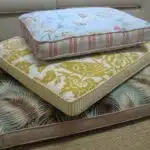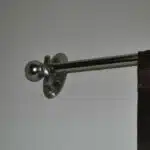Building a Murphy bed is an excellent way to maximize space in your home while still providing a comfortable sleeping area for guests or yourself. A Murphy bed, also known as a wall bed, is a type of bed that can be folded up and stored vertically against the wall when not in use. This type of bed is particularly useful for people who live in small apartments or homes with limited space.
In this article, we will provide step-by-step instructions on how to build your own Murphy bed. We will cover everything from selecting the right materials to installing the finished product. Our goal is to help you create a functional and stylish piece of furniture that will make your life easier and more organized. Whether you are looking to save space, impress your guests, or simply enjoy the satisfaction of building something with your own two hands, our guide will give you all the information you need to get started.
Assessing Your Space And Needs
Have you ever found yourself wishing for more space in your home, but don’t want to sacrifice style or comfort? Look no further than the versatile and functional murphy bed. Not only does it maximize efficiency by providing a comfortable sleeping area that can easily be stowed away when not in use, but it also allows for customization of functionality to fit your unique needs.
Before you begin building your murphy bed, it’s important to assess the space where it will be installed. Consider the dimensions of the room, as well as any obstacles such as windows, doors, or built-in furniture. This will help determine the appropriate size and orientation of the bed. Additionally, think about how often you will be using the bed and who will be sleeping on it. If it will primarily be used by guests, you may choose a different design than if it will be used as a permanent sleeping solution.
Once you’ve determined the best placement and usage for your murphy bed, consider customizing its functionality to suit your needs. For example, you may want to include shelving or storage compartments around the bed for additional organization or use a hydraulic system for easy lifting and lowering. By taking these factors into account during the planning phase of building your murphy bed, you’ll ensure that it not only fits seamlessly into your space but also provides maximum functionality based on your unique needs.
After assessing your space and needs and deciding on a general idea for your murphy bed’s design and style, it’s time to dive deeper into selecting specific features that will make your project truly one-of-a-kind.
Choosing A Design And Style
Murphy beds are a space-saving alternative to traditional beds, and come in a variety of styles, sizes and finishes. When selecting a Murphy bed, it is important to consider the size and layout of the room, as well as features such as the bed’s weight capacity, folding options, and color and material options. It is also important to consider your budget when selecting a Murphy bed, as prices vary widely depending on the design and materials. Lastly, consider any additional space-saving features that may be useful depending on your specific needs.
Types Of Murphy Beds
Choosing a design and style for your murphy bed can be an overwhelming task. With so many options out there, it’s important to consider what type of murphy bed will work best for your space and needs. Two main types of murphy beds are vertical and horizontal, each with their own benefits.
Vertical murphy beds are great for smaller spaces as they take up less floor space when in the upright position. They also tend to be more traditional in design, but can still be customized to fit a modern aesthetic. On the other hand, horizontal murphy beds provide a wider sleeping area and can be great for rooms with lower ceilings. They often have a more modern look and feel.
When choosing between traditional and modern styles, it’s important to consider the overall theme of your space. Traditional murphy beds often have more intricate details such as raised panels or crown molding that can add elegance to a room. Modern murphy beds tend to have clean lines and simple designs that can create a sleek and minimalist look.
Overall, when deciding on what type of murphy bed to build, it’s important to consider both practicality and style. Vertical vs horizontal and traditional vs modern are just two factors among many that should be taken into account before starting your DIY project.
Dimensions And Finishes
When it comes to choosing a design and style for your murphy bed, there are several factors to consider. One of the most important is the dimensions of your space and how they will affect the size of your bed. Customization options abound when it comes to murphy beds, so it’s important to carefully measure your space and choose a size that will be functional yet still fit in with the overall aesthetic.
In addition to considering the size of your space, you’ll also want to think about the finishes and materials you want to use for your murphy bed. Material selection can have a huge impact on both the look and durability of your bed, so it’s important to choose high-quality materials that will stand the test of time. Whether you opt for natural wood or painted finishes, there are plenty of customization options available to help you create a unique piece that fits perfectly in your home.
Ultimately, deciding on the dimensions and finishes for your murphy bed is all about finding a balance between form and function. By carefully considering your needs, preferences, and budget, you can create a custom piece that not only looks great but also provides practical benefits like added storage or extra sleeping space. With so many customization options available, there’s no limit to what you can achieve with a little creativity and some DIY know-how!
Measuring And Cutting Your Materials
Now that you have chosen the design and style of your murphy bed, it is time to move on to the next step which is measuring and cutting your materials. Measuring accuracy is crucial when building furniture, as any small mistake can lead to a big problem later down the line. Therefore, it is essential to invest in a quality tape measure and take precise measurements of your space before purchasing your materials.
Once you have accurate measurements, it’s time to cut your materials. Cutting tools are essential for any DIY project, and a circular saw or table saw can be used for this task. Make sure you have the appropriate safety equipment such as gloves and goggles before starting the cutting process. It is also important to double-check your measurements before making any cuts to avoid wasting materials.
Remember that precision is key when measuring and cutting your materials for a murphy bed. Taking the time to ensure accurate measurements will save you from costly mistakes down the road. In the next section, we will cover an equally important step in building a murphy bed – sanding and finishing.
Sanding And Finishing
As your murphy bed is taking shape, it’s time to start thinking about the final touches. Sanding is an important step in this process as it helps smooth out any rough edges or imperfections in the wood. Start with a coarse-grit sandpaper and gradually work your way up to a finer grit for a smooth finish. It’s crucial to ensure that all surfaces are sanded evenly before moving onto the next step.
Once the sanding is complete, you can begin applying stain to enhance the natural beauty of the wood. Choose a color that complements your room’s decor and apply it evenly using a brush or cloth. Make sure to wipe off any excess stain after application, as leaving it on can cause uneven coloring or blotches. Allow ample drying time before applying a second coat if necessary.
If you prefer not to use stain, paint is another option for finishing your murphy bed. Choosing paint colors can be overwhelming, but keep in mind that lighter colors will make your room feel more spacious while darker colors add warmth and coziness. Use high-quality paint and brushes for even coverage and allow each coat to dry completely before applying another layer. Once the painting is complete, give it plenty of time to dry before moving on to creating the bed frame.
With the sanding and finishing done, your murphy bed is one step closer to becoming a functional piece of furniture in your home. Next up, we’ll delve into creating the bed frame itself – an exciting part of this DIY project!
Creating The Bed Frame
To create the bed frame for your Murphy bed, you will first need to select the appropriate materials. The most important material is the wood that will be used for the frame. It must be sturdy enough to support the weight of the mattress and any additional bedding, but also lightweight enough to allow for easy lifting and lowering of the bed. Plywood or MDF are common choices due to their strength and affordability.
Once you have selected your materials, it is time to begin assembling the frame. Start by measuring and cutting your pieces according to your chosen design. Next, use assembly techniques such as pocket hole joinery or mortise and tenon joints to securely fasten all of the pieces together. It is important that each piece is aligned properly before securing them together, as any misalignment could cause issues when installing the mechanism later on.
Throughout this process, remember that safety should always come first. Always wear appropriate safety gear like goggles and gloves when using tools and handling materials. Additionally, ensure that all screws and other fasteners are properly tightened before moving onto the next step.
With your bed frame assembled, you are now ready to move on to installing the mechanism that will allow it to fold up into a wall-mounted cabinet. This next step requires precise measurements and careful installation techniques in order to ensure that your Murphy bed functions safely and smoothly.
Installing The Mechanism
Choosing the mechanism for a Murphy bed requires careful consideration of the style, size, weight, and intended use of the bed. Installing the mechanism involves affixing the appropriate components to the bed frame and wall, and ensuring the bed is securely fastened. After installation, testing the mechanism should be done to ensure the bed is safe to use and that all components are in working order. Additionally, it is important to ensure the bed is level and all connections are secure. Once the mechanism is tested and proven to be sound, the Murphy bed is ready for use.
Choosing The Mechanism
Are you looking to build your own Murphy bed? One of the most important steps in the process is choosing the mechanism that will be used. There are a few different options out there, each with their own pros and cons.
First up is the piston lift mechanism. This is one of the more popular options as it’s easy to use and provides a smooth transition from bed to wall. The downside? It can be on the pricey side, so budget considerations should definitely come into play. If you’re willing to splurge, however, this mechanism can make your life a lot easier.
Another option is the spring lift mechanism. This choice is typically more affordable than pistons, but it may not be as user-friendly as its counterpart. That being said, it can still do the trick if you’re looking for something functional without breaking the bank. Just keep in mind that installation may require some extra effort.
Lastly, there’s the DIY route. If you’re feeling particularly crafty or want to save some money, building your own mechanism could be an option worth considering. However, this requires some serious know-how and skill in order to ensure safety and functionality. Plus, depending on what materials you use, it may end up costing just as much as a pre-made option.
No matter which route you choose when selecting your Murphy bed mechanism, pros and cons should be weighed carefully along with budget considerations before making a decision. Happy building!
Installing The Mechanism
When it comes to building your own Murphy bed, one of the most important steps is installing the mechanism. While this may seem like a daunting task, it’s actually quite straightforward with a little bit of know-how. First off, be sure to carefully read the instructions that come with your chosen mechanism and gather all necessary tools before getting started.
One common problem when installing a Murphy bed mechanism is ensuring that it’s level. This is crucial for proper operation and safety. Use a level tool to ensure that everything is lined up correctly and adjust as needed. Additionally, be sure to securely anchor the mechanism to the wall studs for added stability.
Maintenance tips for your Murphy bed mechanism include periodically checking for loose screws or bolts and tightening them as needed. Lubricating moving parts with a silicone spray can also help keep things running smoothly. And if you notice any unusual noises or difficulties when operating the bed, don’t hesitate to seek out professional help or consult the manufacturer’s troubleshooting guide. By taking these steps, you can ensure that your Murphy bed will provide years of comfortable and convenient use.
Testing The Mechanism
Now that the Murphy bed mechanism has been installed, it’s time to test it out. Testing the mechanism is crucial for ensuring that it’s safe and functioning properly. Before testing, be sure to remove any bedding or other items from the bed frame to prevent damage.
To test the mechanism, start by opening and closing the bed a few times to make sure everything is moving smoothly. Pay attention to any unusual noises or resistance. If something doesn’t feel right, stop and consult the manufacturer’s troubleshooting guide or seek professional help. It’s better to address any issues before using the bed regularly.
Once you’re satisfied that everything is working as it should, it’s important to continue regular maintenance checks on your Murphy bed mechanism. This includes periodically checking for loose screws or bolts and tightening them as needed, as well as lubricating moving parts with a silicone spray. By following these maintenance tips and addressing any issues promptly, you can ensure that your Murphy bed will provide years of comfortable and convenient use for yourself or your guests.
Attaching The Bed To The Wall
When it comes to attaching the Murphy bed to the wall, there are several methods that you can choose from. One of the most popular methods is using a cleat system that involves securing a wooden cleat onto the wall with screws. This cleat will then be used to support the weight of the bed frame and mattress. Another option is to use metal brackets that attach directly onto the wall studs and provide sturdy support for your bed.
Regardless of which method you choose, it’s crucial to take safety precautions during installation. Always make sure that you have correctly located and marked the studs in your wall before drilling any holes. Additionally, it’s essential to use appropriate hardware that can handle the weight of your Murphy bed, including heavy-duty screws and bolts.
By following proper installation techniques and taking necessary safety measures, you can ensure that your Murphy bed is attached securely to your wall without posing any danger or risk of falling. In the next section, we will discuss how adding support and braces can further enhance stability and durability for your Murphy bed.
Adding Support And Braces
- When building a Murphy bed, the strength of the wall should be determined to ensure safe and secure installation.
- Once the wall strength has been established, the appropriate wall brackets should be selected and securely attached to the wall.
- The installation of the bed supports should be done in accordance with the manufacturer’s instructions, making sure to securely attach them to the wall brackets.
- The bed supports should be inspected to make sure they are level and securely mounted to the wall.
- To ensure the bed is properly supported, more brackets may be needed and should be added if necessary.
- All hardware should be securely tightened to ensure the bed is safe and secure when in use.
Determine Wall Strength
Determining wall strength is a crucial step in building a murphy bed. This subtopic is important because the weight capacity of the bed depends on the wall’s strength, and reinforcing weak spots can prevent accidents from happening. Before starting the project, it is essential to identify which wall will support the bed and determine its weight-bearing capacity.
To determine the wall strength, you need to locate the studs in your walls. Studs are vertical framing members that provide support for your walls and are typically spaced 16 or 24 inches apart. You can use a stud finder to locate them easily. Once you’ve located them, mark their location with a pencil. Then, measure between the studs to find their exact spacing.
After locating the studs, you need to reinforce weak spots in your walls if any. These could be areas around windows or doors where there may be less support than other parts of the wall. To reinforce these areas, you can add extra supports such as cross braces or sistered studs. By ensuring that your wall is strong enough to support your murphy bed’s weight capacity, you’ll be able to sleep soundly knowing that it’s safe and secure.
Attach Brackets Securely
To ensure that your murphy bed is safe and secure, it’s essential to add support and braces to the wall where it will be attached. Besides reinforcing weak spots in the wall, you’ll need to attach brackets securely to distribute the weight of the bed evenly. This subtopic discusses the bracket types and installation techniques that you should use when attaching brackets to your wall.
There are two main types of brackets that you can use when installing a murphy bed: L-shaped brackets and T-shaped brackets. L-shaped brackets are used for vertical mounting, while T-shaped brackets are used for horizontal mounting. Both types of brackets come in different sizes and strengths, so choose one that’s appropriate for your specific needs.
When installing the brackets, make sure they are attached to the studs securely. Use screws that are long enough to penetrate at least 1-1/2 inches into the stud. It’s also essential to pre-drill pilot holes before screwing in the screws to prevent splitting or cracking of the wood. Once you’ve installed all of the brackets, test their strength by applying pressure on them before attaching your murphy bed frame.
In conclusion, attaching brackets securely is an essential step in adding support and braces to your murphy bed’s wall. Choose appropriate bracket types based on your needs, install them using proper techniques such as pre-drilling pilot holes, and test their strength before proceeding with adding your murphy bed frame. By following these steps carefully, you’ll have peace of mind knowing that your murphy bed is secure and safe for use.
Install Bed Supports
Now that you’ve installed the brackets securely, the next step is to add bed supports to ensure that your murphy bed can handle weight and pressure. Bed supports are essential for distributing the weight of the mattress evenly and preventing sagging over time. There are different material options for bed supports, including metal frames, wooden slats, and plywood boards.
When selecting a bed support material, consider the weight capacity of your murphy bed frame and mattress. The bed support should be strong enough to support the combined weight of the frame, mattress, and bedding without bending or breaking. If you’re unsure about which material option to choose, consult with a furniture expert or read reviews from other DIYers who have built their own murphy beds.
Once you’ve selected a bed support material, install it according to manufacturer instructions or DIY guides. Make sure that it’s level and even on both sides to prevent uneven weight distribution. You may also want to add additional reinforcement in areas where more weight will be concentrated, such as around the center of the bed. By taking these steps to add proper bed supports, you’ll ensure that your murphy bed is safe and comfortable for years to come.
Constructing The Surrounding Cabinet
With the addition of support and braces, your Murphy bed frame is now sturdy and ready for the next step: constructing the surrounding cabinet. This step is crucial in maximizing storage space in your room, as it will serve not only as a frame for the bed but also as a functional storage unit. Customizing the cabinet design to fit your specific needs and preferences is key in creating a unique piece that meets all your requirements.
Before you start building, consider what type of items you plan to store in the cabinet. Will it be used mainly for clothes or books? Do you need space for shoes or additional bedding? Once you have a clear idea of what items you want to store, you can begin designing the cabinet’s layout. A three-item numeric list that can help maximize storage includes utilizing vertical space with tall shelves, incorporating pull-out drawers for easy access, and adding adjustable shelves to accommodate changing needs.
When constructing the cabinet, pay attention to details such as matching wood grains and ensuring proper alignment of all parts. The finish on the cabinet should complement the bed frame and other furniture in your room. Remember that this piece serves both aesthetic and functional purposes, so take time to make sure it meets all your needs. With a well-designed and carefully constructed cabinet, your Murphy bed will not only provide comfortable sleeping accommodations but also ample storage space for years to come.
As you move onto installing shelves and drawers, keep in mind that these elements are critical components of your Murphy bed’s functionality. Without proper organization options within the surrounding cabinet, clutter can easily accumulate around your bed area. In order to create an efficient use of space within this wall unit, each shelf should be measured precisely so there are no wasted gaps between items stored on them. Additionally, drawers should be installed with high-quality glides that allow them to open smoothly without resistance or sticking. By carefully considering these details during installation, you can ensure that everything about your Murphy bed works seamlessly together.
Installing Shelves And Drawers
As you continue building your Murphy bed, it’s essential to consider the space underneath the bed frame. Installing shelves and drawers is an excellent way of maximizing storage in your room while keeping everything organized. Shelves and drawers also allow you to keep your essentials within reach without cluttering up the floor space.
When installing shelves, ensure that they are sturdy enough to hold all your items safely. You can customize the finishes on your shelves and drawers using paint, wood stain, or any other material that matches your decor. If you’re using reclaimed wood for this project, sand it down before applying any finish to prevent splinters.
With shelves and drawers installed under your Murphy bed frame, it’s time to move onto finishing touches and hardware. These elements will help you complete the look of your project while adding functionality. Keep reading for tips on how to select hardware that enhances the design of your Murphy bed while serving its purpose effectively.
Finishing Touches And Hardware
Once you have built the frame and installed the lift mechanism, it’s time to move on to the finishing touches and hardware selection. The right hardware will ensure that your Murphy bed looks great and functions smoothly for years to come. When selecting hardware, consider factors such as weight capacity, ease of use, and durability. You can find a variety of Murphy bed hardware kits online or at your local home improvement store.
Installation tips for Murphy bed hardware can vary depending on the specific kit you choose. However, there are some general guidelines to follow. First, make sure you have all necessary tools before starting installation. Common tools include a drill, screwdriver, level, and measuring tape. Next, carefully read through the instructions provided with your hardware kit. It’s also helpful to watch online tutorials or read reviews from other DIY builders who have used the same kit.
In addition to selecting high-quality hardware and following proper installation procedures, there are a few additional finishing touches that can elevate your Murphy bed’s appearance and functionality. Consider adding decorative molding or trim around the frame to give it a more polished look. You may also want to add shelving or storage compartments within the frame itself. Finally, don’t forget about bedding! Choose sheets and blankets that complement your decor style while also being practical for frequent folding up and down.
- Hardware selection:
- Weight capacity
- Ease of use
- Durability
Now that you have completed all of the necessary steps in building your Murphy bed frame and installing its lift mechanism along with finishing touches like trim molding or storage compartments within the frame itself – it is time to test out how well everything works together! In order for this process to go smoothly without any issues arising during use later on down the line when trying to fold up or down again after having been set up once already – we recommend testing each component individually first before putting them all back together again as one unit.
Testing And Adjusting The Mechanism
Once you have assembled the mechanism of your Murphy bed, it is important to test and adjust it before installing the bed into your living space. As they say, “measure twice, cut once.” This idiom rings true when building a piece of furniture as complex as a Murphy bed. Testing the mechanism before installation can prevent any mishaps or accidents that may occur while using the bed.
Adjusting tension is one key component to testing and adjusting the mechanism. The tension in the springs must be just right in order for the bed to open and close smoothly. To adjust the tension, use a wrench to turn the tension rods located at the bottom of each spring. Turn clockwise for more tension and counterclockwise for less. It may take some trial and error to get it just right.
Lubrication techniques should also be utilized during testing and adjusting of your Murphy bed’s mechanism. Use silicone spray on all moving parts such as hinges, springs, and pivot points for smooth operation. Avoid using oil-based lubricants as they may attract dust and dirt which will cause friction over time. Proper lubrication will ensure that your Murphy bed operates flawlessly for years to come.
To move forward with bedding and mattress selection, first ensure that your Murphy bed’s mechanism is working properly by testing and adjusting its tension and utilizing proper lubrication techniques. Once you are satisfied with its performance, move on to selecting bedding and a mattress that will fit within your space constraints while providing comfort for overnight guests.
Bedding And Mattress Selection
When it comes to building a Murphy bed, one important aspect to consider is the bedding and mattress selection. After all, this is what will provide comfort and support for the sleeper. There are many factors that can influence your decision including size, material, and personal preferences.
Mattress types vary greatly in terms of size, thickness, firmness or softness, support level, and price. When choosing a mattress for your Murphy bed, it is important to consider the amount of space you have available when the bed is folded up. It may also be necessary to select a thinner mattress than what you would use on a traditional bed. Memory foam mattresses are popular choices due to their ability to conform to your body shape while providing good support.
Bedding materials can also make a big difference in how comfortable your Murphy bed feels. Generally speaking, natural fibers such as cotton or linen are more breathable and help regulate temperature better than synthetic materials like polyester. Additionally, high thread count sheets tend to be softer and more durable than lower thread count options.
Properly selecting bedding and mattress materials can go a long way towards ensuring that your Murphy bed provides both comfort and function. Consider factors such as size, material type, and personal preferences when making these decisions. In the next section we will discuss maintenance and care tips for keeping your Murphy bed in top condition.
Maintenance And Care
While selecting the perfect bedding and mattress for your Murphy bed is crucial, maintenance and care are equally important. After all, regular upkeep helps prolong the lifespan of your furniture and ensures that it remains in good condition for years to come.
Cleaning tips: To keep your Murphy bed looking fresh and clean, it’s essential to regularly dust and vacuum the surface. For particularly stubborn stains or spills, use a mild soap solution with a soft cloth to gently scrub away any marks. Avoid using harsh chemicals or abrasive materials that could damage the finish of your bed.
Preventative measures: One of the easiest ways to prevent wear and tear on your Murphy bed is by ensuring that it’s properly installed from the get-go. Follow all manufacturer instructions carefully, and make sure that you’re using appropriate hardware to secure the bed frame to the wall. Additionally, try not to overload your bed with too much weight or pressure – this can cause undue stress on the frame over time.
Moving forward from maintenance and care, let’s take a look at some common issues you might encounter while building or using a Murphy bed. By being aware of potential problems ahead of time, you’ll be better equipped to troubleshoot any issues that arise down the line.
Troubleshooting And Common Issues
When it comes to building a Murphy bed, there are a few common issues that you may encounter. One issue is adjusting the tension of the springs. If the bed is too difficult to lift or lower, you may need to adjust the tension by tightening or loosening the springs. This can be done by turning the adjustment screws located on each side of the bed frame. It’s important to make sure that both sides are adjusted evenly to ensure proper operation.
Another common issue with Murphy beds is proper alignment. If the bed doesn’t line up correctly when closing, it may be due to a misalignment of the hinges or frame. To fix this, check that all screws are tightened and adjust any hinges as needed. It’s also important to make sure that the frame is level before installing it, as an uneven installation can cause alignment issues down the line.
Finally, if you’re experiencing any other issues with your Murphy bed, don’t hesitate to consult a professional for assistance. They can help diagnose and fix any problems you may be having, ensuring that your DIY project is a success in every way possible. With these tips in mind, you’ll be able to troubleshoot any issues with your Murphy bed and enjoy its convenience and functionality for years to come!
Conclusion
Building a Murphy bed is not only a practical solution for maximizing your space, but it can also be a fun and rewarding DIY project. By following these steps, you can create a customized piece of furniture that meets your specific needs and style preferences.
After assessing your space and needs, choosing a design and style, measuring and cutting your materials, sanding and finishing, creating the bed frame, testing and adjusting the mechanism, selecting bedding and mattress options, and learning about maintenance and troubleshooting tips, you’ll have a beautiful and functional Murphy bed that will provide years of use.
Remember that building a Murphy bed requires precision and attention to detail. Take your time during each step of the process to ensure that everything fits together properly. With patience and perseverance, you’ll soon have a stunning piece of furniture that seamlessly blends into your home’s decor while providing ample sleeping space for guests or yourself. So go ahead – unleash your inner DIY furniture expert!
Image Credits
- “Murphy Bed, Opened” by Arthaey (featured)





























